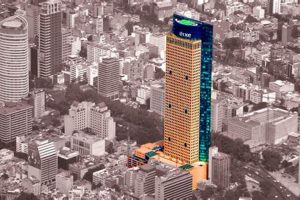Gazing upward to skyscrapers, these towering titans of architecture, can evoke a sense of awe and inspiration within us. Standing at their base, we crane our necks to take in their sheer magnitude, their facades reaching towards the heavens. Whether it’s the iconic Empire State Building in New York City or the futuristic Burj Khalifa in Dubai, these architectural marvels dominate skylines across the globe.
The act of looking up at skyscrapers holds significant importance. It encourages us to appreciate the ingenuity and creativity of human engineering. These structures represent the pinnacle of architectural prowess and serve as symbols of urban progress. Additionally, they provide a unique perspective on our surroundings, allowing us to see our cities from a new vantage point. The upward gaze also fosters a sense of wonder and humility, reminding us of our place within the vastness of the urban landscape.
In the following sections, we will delve deeper into the various aspects of skyscrapers, exploring their history, design principles, and impact on urban environments. We will also examine how they have become iconic landmarks and symbols of cultural identity.
1. Height
When we look up at skyscrapers, their towering height is one of the first things that captures our attention. These man-made giants are a testament to the ingenuity and engineering prowess of humanity. The ability to construct such massive structures that reach towards the heavens is a marvel of modern architecture and engineering.
- Structural innovation: Skyscrapers require innovative structural systems to withstand gravity, wind, and seismic forces. Engineers have developed various techniques, such as reinforced concrete, steel frames, and composite structures, to ensure the stability of these towering buildings.
- Material advancements: The construction of skyscrapers has been made possible by advancements in material science. High-strength steel, lightweight composite materials, and reinforced concrete allow architects and engineers to create structures that are both strong and efficient.
- Vertical transportation: As skyscrapers grew taller, the need for efficient vertical transportation became paramount. The invention of elevators and the development of advanced elevator systems have made it possible to move people and goods quickly and safely between floors.
- Facade engineering: The facades of skyscrapers play a crucial role in managing sunlight, heat gain, and wind loads. Architects and engineers collaborate to design facades that are not only aesthetically pleasing but also functional and sustainable.
The height of skyscrapers not only symbolizes human ambition but also represents the continuous pursuit of innovation and engineering excellence. Looking up at these towering structures inspires us to think big and to strive for new heights in all aspects of life.
2. Design
The design of skyscrapers is an integral aspect of the experience of looking up at them. The architectural styles and design principles employed in their construction shape our perception and appreciation of these towering structures.
Different architectural styles, such as Art Deco, Gothic Revival, and Brutalist, have left their mark on the skylines of cities around the world. Each style brings its own unique aesthetic and functional characteristics to the design of skyscrapers. For example, Art Deco skyscrapers are known for their sleek lines, geometric forms, and decorative ornamentation, while Brutalist skyscrapers are characterized by their raw concrete facades and bold, geometric shapes.
The design of skyscrapers also reflects the functional requirements of the building. Factors such as the building’s intended use, the local climate, and the available construction materials all influence the design decisions made by architects and engineers. For instance, skyscrapers in earthquake-prone areas may incorporate seismic design features, while skyscrapers in cold climates may have facades designed to minimize heat loss.
Understanding the design principles behind skyscrapers enhances our appreciation of these architectural marvels. By looking up at skyscrapers and examining their design elements, we can gain insights into the creativity, ingenuity, and engineering prowess of those who designed and built them. This understanding not only enriches our experience of looking at skyscrapers but also fosters a greater appreciation for the built environment around us.
3. Perspective
The act of looking up at skyscrapers offers not only an awe-inspiring visual experience but also a unique vantage point that transforms our perspective on the urban landscape. By craning our necks upwards, we gain a new understanding of our surroundings, fostering a sense of wonder and encouraging us to appreciate the intricate details of our cities.
- Verticality and Scale: Skyscrapers challenge our perception of verticality and scale. By looking up at these towering giants, we gain a renewed appreciation for the sheer size and height of these structures, emphasizing the vertical dimension of our cities and reminding us of our place within the vastness of the urban environment.
- Urban Context: Looking up at skyscrapers allows us to see buildings in relation to one another, revealing the urban fabric and the interplay between different architectural styles and periods. This vantage point enhances our understanding of how skyscrapers interact with their surroundings, shaping the overall character and identity of the city.
- Architectural Details: When we look up at skyscrapers, we can observe intricate architectural details that are often missed when viewed from ground level. This elevated perspective allows us to appreciate the craftsmanship, ornamentation, and design elements that contribute to the aesthetic appeal and architectural significance of these structures.
- Human Perspective: Looking up at skyscrapers can also provide a unique perspective on human activity within the urban environment. The bustling streets and sidewalks below take on a new dimension when viewed from above, highlighting the movement and interactions of people as they navigate the city.
By offering a unique vantage point on our surroundings, looking up at skyscrapers encourages us to see our cities in a new light. It fosters a deeper appreciation for the architectural wonders that shape our environment and reminds us of the human stories and activities that unfold within the urban landscape.
4. Awe
When we look up at skyscrapers, their sheer scale and grandeur have a profound impact on our emotions. The towering height and imposing presence of these architectural marvels can evoke a sense of awe and humility within us. This feeling of awe is not merely a passive admiration; it actively shapes our perception of the world around us and our place within it.
Awe, in the context of looking up at skyscrapers, is a complex emotion that encompasses a mix of wonder, reverence, and even a touch of fear. It is a recognition of the immense power and ingenuity of human creation, coupled with a humbling realization of our own smallness in the face of such structures. This emotional response is not limited to individuals with a particular background or expertise; it is a universal human experience that transcends cultural and societal boundaries.
The practical significance of understanding the connection between awe and looking up at skyscrapers lies in its potential to enhance our appreciation for architecture and urban environments. By recognizing the awe-inspiring qualities of skyscrapers, we can develop a deeper connection to our built environment and a greater sense of pride in our cities. This understanding can also inspire us to think more critically about the role of architecture in shaping our lives and to demand higher standards for the design and construction of our buildings.
In conclusion, the connection between awe and looking up at skyscrapers is a powerful and multifaceted one. It is an emotional response that is both deeply personal and universally shared, and it has the potential to shape our perception of the world around us and inspire us to create more awe-inspiring spaces for ourselves and for future generations.
5. Symbolism
Skyscrapers, with their towering heights and distinctive designs, often become iconic landmarks that embody the spirit and identity of a city or nation. Looking up at these architectural marvels, we not only appreciate their aesthetic grandeur but also connect with the deeper meanings they hold. This symbolic significance adds another layer to the experience of looking up at skyscrapers, enriching our understanding of their role in shaping urban landscapes and cultural narratives.
- Pride and Identity: Skyscrapers serve as sources of pride and identity for the communities they reside in. They represent the aspirations, achievements, and collective spirit of the city or nation. Looking up at these towering structures, citizens can feel a sense of belonging and shared purpose.
- Economic Power and Prosperity: Skyscrapers are often associated with economic power and prosperity. The presence of tall buildings in a city’s skyline can symbolize its economic strength and global competitiveness. Looking up at these structures, we can gain insights into the economic landscape and the city’s position in the global market.
- Architectural Innovation and Engineering Prowess: Skyscrapers showcase the latest advancements in architectural design and engineering prowess. They push the boundaries of what is structurally possible and serve as testaments to human ingenuity. Looking up at these architectural wonders, we can appreciate the creativity and innovation that shape our built environment.
- Cultural Heritage and Legacy: Skyscrapers can become cultural landmarks that represent a city’s heritage and legacy. They may be associated with significant historical events, cultural movements, or architectural styles. Looking up at these structures, we can connect with the past and gain a deeper understanding of the city’s cultural identity.
In conclusion, the symbolic significance of skyscrapers adds depth and meaning to the experience of looking up at them. These architectural marvels not only dominate skylines but also embody the aspirations, achievements, and cultural identity of the communities they represent. Understanding and appreciating this symbolism enriches our appreciation for skyscrapers and enhances our connection to the urban environment.
6. Urbanism
Looking up at skyscrapers, we often marvel at their architectural grandeur and engineering feats. However, beyond their aesthetic appeal, skyscrapers play a significant role in shaping urban environments. Their presence impacts population density, transportation patterns, and economic development, making them central to the study of urbanism.
Skyscrapers, by their nature, increase population density within a concentrated area. This vertical growth allows cities to accommodate more people without expanding their physical boundaries. The resulting high-density living has implications for housing affordability, urban infrastructure, and the provision of essential services. Looking up at skyscrapers, we can observe how they contribute to the vibrant tapestry of urban life.
Transportation patterns are also influenced by skyscrapers. Densely populated areas around skyscrapers create demand for efficient public transportation systems. This in turn reduces reliance on personal vehicles, alleviating traffic congestion and promoting sustainable urban mobility. Looking up at skyscrapers, we can appreciate their role in fostering walkability, cycling, and the use of public transportation.
Furthermore, skyscrapers serve as economic powerhouses. They often house corporate headquarters, financial institutions, and other businesses. The concentration of economic activities in these vertical hubs attracts skilled workers, promotes innovation, and generates employment opportunities. Looking up at skyscrapers, we can recognize their contribution to the economic vitality and competitiveness of cities.
Understanding the connection between skyscrapers and urbanism is crucial for architects, urban planners, and policymakers. It highlights the need for integrated urban planning strategies that consider the long-term effects of skyscraper development. By looking up at skyscrapers and examining their impact on urban environments, we gain valuable insights into creating sustainable, livable, and economically vibrant cities.
7. Inspiration
The upward gaze towards skyscrapers can evoke a sense of inspiration, unlocking creativity, innovation, and a sense of possibility within us. These towering structures, with their grandeur and architectural prowess, serve as a catalyst for our imagination, encouraging us to think beyond the ordinary and to strive for new heights in our own endeavors.
- Awe and Wonder: Looking up at skyscrapers, we are filled with a sense of awe and wonder. Their sheer scale and intricate designs spark our imagination and ignite a desire to create something equally remarkable.
- Verticality and Ambition: The verticality of skyscrapers symbolizes ambition and the pursuit of excellence. By looking up at these structures, we are reminded to set our sights high and to strive for continuous improvement.
- Architectural Innovation: Skyscrapers showcase the latest advancements in architectural design and engineering. Observing
their innovative forms and sustainable features can inspire us to think outside the box and to explore new possibilities in our own projects. - Urban Potential: Skyscrapers represent the potential of urban environments. They demonstrate how we can use space creatively and efficiently to build thriving and sustainable cities.
In conclusion, the upward gaze towards skyscrapers serves as a powerful source of inspiration. It encourages us to dream big, to innovate boldly, and to believe in the possibility of achieving our aspirations. By looking up at these architectural marvels, we can unlock our own creativity and potential, shaping a brighter and more innovative future.
FAQs about Looking Up at Skyscrapers
This FAQ section provides concise answers to commonly asked questions about looking up at skyscrapers. It aims to clarify misconceptions and offer additional insights into this captivating experience.
Question 1: What is the significance of looking up at skyscrapers?
Looking up at skyscrapers holds significant importance as it allows us to appreciate architectural ingenuity, marvel at engineering feats, gain a new perspective on our surroundings, and experience a sense of awe and inspiration.
Question 2: How does looking up at skyscrapers inspire creativity?
The upward gaze towards skyscrapers evokes a sense of awe and wonder, igniting our imagination and inspiring us to think beyond the ordinary. These structures serve as a reminder to set our sights high and to strive for continuous improvement.
Question 3: What can we learn from the design of skyscrapers?
Skyscrapers showcase the latest advancements in architectural design and engineering. By observing their innovative forms and sustainable features, we can gain valuable insights into space utilization, structural efficiency, and environmentally conscious construction practices.
Question 4: How do skyscrapers contribute to the urban environment?
Skyscrapers play a crucial role in shaping urban environments. They increase population density, influence transportation patterns, and serve as economic powerhouses. By examining their impact, we can better understand the dynamics of urban growth and the need for integrated planning strategies.
Question 5: What is the cultural significance of skyscrapers?
Skyscrapers often serve as iconic landmarks and symbols of cultural identity. They represent the aspirations and achievements of a city or nation, reflecting its economic strength, architectural innovation, and historical legacy.
Question 6: How can we appreciate the beauty of skyscrapers?
To fully appreciate the beauty of skyscrapers, take time to observe their architectural details, consider their historical context, and understand the engineering marvels that make them possible. By engaging in active observation and thoughtful reflection, we can gain a deeper appreciation for these architectural wonders.
In summary, looking up at skyscrapers is a multifaceted experience that offers insights into architecture, engineering, urbanism, and cultural identity. By understanding the significance and nuances of this experience, we can enhance our appreciation for these towering structures and the role they play in shaping our built environment.
To delve deeper into the world of skyscrapers, explore the following sections of this article:
Tips for Enhancing the Experience of Looking Up at Skyscrapers
To fully appreciate the architectural grandeur and significance of skyscrapers, consider the following tips:
Tip 1: Observe Architectural Details
Pay attention to the building’s facade, ornamentation, and structural elements. Examine how these details contribute to the overall aesthetic and architectural style of the skyscraper.
Tip 2: Consider Historical Context
Research the history of the skyscraper and its surrounding area. Understanding the building’s origins, purpose, and architectural influences can deepen your appreciation for its design and significance.
Tip 3: Understand Engineering Marvels
Skyscrapers are feats of engineering. Learn about the innovative structural systems, materials, and construction techniques that make these towering structures possible.
Tip 4: Explore Different Perspectives
Move around the skyscraper to observe it from various angles. Note how the building’s appearance and relationship to its surroundings change with perspective.
Tip 5: Visit at Different Times of Day
The lighting conditions throughout the day can dramatically alter the appearance of a skyscraper. Visit the building at dawn, dusk, or night to experience its changing moods and ambiance.
Tip 6: Engage with the Surroundings
Take note of the surrounding urban environment. Observe how the skyscraper interacts with the streets, plazas, and neighboring buildings, and how it contributes to the overall character of the city.
Summary of Key Takeaways:
- Observing architectural details enhances appreciation for design and craftsmanship.
- Understanding historical context provides insights into the building’s significance.
- Recognizing engineering marvels fosters admiration for human ingenuity.
- Exploring different perspectives offers a comprehensive view of the skyscraper’s form.
- Visiting at different times of day showcases the building’s changing appearance.
- Engaging with the surroundings deepens understanding of the skyscraper’s urban context.
By incorporating these tips into your experience of looking up at skyscrapers, you can gain a richer appreciation for their architectural beauty, historical significance, and engineering prowess.
Transition to the article’s conclusion…
Conclusion
Looking up at skyscrapers is an awe-inspiring experience that offers a unique perspective on architecture, engineering, and urbanism. It encourages us to appreciate the ingenuity and ambition that have shaped our built environment, and to reflect on the role of skyscrapers in our cities and our lives.
As we have explored in this article, skyscrapers are more than just tall buildings. They are symbols of human achievement, testaments to engineering prowess, and reflections of cultural identity. They shape our skylines, influence our transportation patterns, and contribute to the economic vitality of our cities. By understanding the significance and nuances of looking up at skyscrapers, we can gain a deeper appreciation for these architectural wonders and the role they play in shaping our world.







